
Amazon (AWS): Removing Friction from Enterprise XR
- March 29, 2023
Listen and Subscribe on Your Favorite Platform:
Episode Summary
In this episode of the podcast, we sit down with Stephen Curtis, a Senior Prototyping Architect working in Spatial Computing at AWS. Stephen shares his insights on how to get started with immersive technology and the journey AWS took to start taking XR seriously.
We discuss how technology can be used to remove friction in enterprise, give examples of enterprise friction in XR, and how AWS helps customers with their journey into XR.
We dive deeper into operational excellence, and managing content and devices for XR. We also discuss the best approach for XR content authoring and whether companies should use authoring tools or apps.
For companies starting a pilot project, Stephen shares his advice and established use cases. We also discuss the XR use cases that Stephen is most excited about and how to quantify data for efficacy.
As the conversation turns towards the Metaverse, we explore whether it will be one world or multiple worlds, and whether it should be open-source. Finally, we discuss what might surprise us about XR or the Metaverse in 10 years!
Join us for this insightful conversation on the future of immersive technology and XR for enterprise.
Key Moments
- Getting started with immersive technology (0:22-4:25)
- 50 things Stephen learned since 30 (4:25-6:55)
- Technology as a goal to remove friction (7:41-10:04)
- Examples of enterprise friction that AWS can solve (10:20-12:35)
- What was the journey for AWS to start taking XR seriously (12:45-15:54)
- Where is our progress on where VR is with real-world applications? (15:55-18:08)
- How does AWS help customers with their journey into XR (18:09-20:30)
- Operational excellence, manage devices (ArborXR), manage code (20:38-21:48)
- What’s the best approach for XR content authoring/XR Content (21:48-24:11)
- Advice for companies starting a pilot project (25:28-28:03)
- What XR use cases are you most excited about (28:04-29:22)
- Will the Metaverse be one world or multiple worlds? (31:18-36:13)
- What may surprise us about XR or the Metaverse in 10 years? (38:28-41:12)

About the Guest
Stephen is a Senior Prototyping Architect for the Worldwide Specialist Organization on Spatial Computing. He currently works with AWS customers, APN partners, and AR/VR device manufacturers to leverage cloud-based technologies to build immersive and spatially aware experiences.
Stephen has developed and/or led over a dozen successful prototyping engagements for some of the largest AWS global customers (including BMW). With industries including automotive, telecommunications, energy, manufacturing, biomedical research, and pharmaceutical technologies. Specializing in taking bleeding edge technologies and bringing them to enterprise. He was also the lead developer on the Visual Asset Management System (VAMS), a spatial data lake reference architecture which is now the foundation of the AWS go-to-market strategy for spatial computing.
Prior to AWS, Stephen has been an enterprise-level developer, architect and technical leader for nearly 20 years. Working with global-scale companies in the travel and hospitality, marketing technology, startup consulting, video game, construction, utilities, media and entertainment, luxury brand, retail and fashion industries.
Links and Resources
Learn more about getting started with XR in our ultimate guide to managing VR training for work.
Episode Transcript
Brad Scoggin: Hey there, welcome to “XR Industry Leaders” with ArborXR. My name is Brad Scoggin, and I am the CEO and one of three co-founders of ArborXR. And we’ve had the opportunity of working with thousands of companies since 2016, and we’ve learned a ton about what it takes for XR to be successful in your organization.
Will Stackable: And I’m Will Stackable, co-founder and CMO. This podcast is all about interviewing the leaders who are on the ground making XR happen today. True pioneers in the space from Amazon, Walmart, and UPS to Koch, Pfizer, and beyond to uncover the pitfalls, lessons learned, and secrets that you can use to help grow XR in your organization.
Brad Scoggin: Well, Stephen, thanks so much for sitting down with us today.
Stephen Curtis: I’m glad to be here.
Brad Scoggin: I would love to start out by just hearing a little bit about your personal journey into XR.
Stephen Curtis: Well, I think, like a lot of folks that do what I do and have been drawn to AWS, it started when I was a kid and falling in love with the internet and with Sci-Fi and with video games. I discovered the internet when I was in fourth grade in 1994, and I became obsessed with it. And I spent most of my childhood just trying to acquire the hardware and the access to be able to get onto the internet and then build websites. I was obsessed with websites and also, sort of in the background, had this interest in building video games but really, it was building things on the internet that was my passion. So that led me to start working at a small local ISP when I was in high school, and then even while I was in the military, I would still be doing small web application-based projects for the different military units I was with. And then, when I got out of the military, I immediately went to work as a full-stack web application developer. And over the course of my career post-military, I ended up working for almost every vertical imaginable, building anything that you could build that was sort of at a commercial or enterprise-grade full stack. But as long as it had a sort of a front-end component that was based on internet connectivity. So that took me through marketing, PR, hospitality, construction, energy, entertainment. So by the time, the last role I had before AWS was working with Nike. So by the time I landed with AWS, which is the place where you could kind of build anything because of the number of options of services, I ended up finding a home with this team called Prototyping. And Prototyping focuses on sort of taking the customers that have challenges that they can’t really figure out based on what they’ve built before, and there’s not a really good reference architecture before. So they need this team to come together and sort of solve the problem and build a prototype to prove it, which is handy if you have a sort of a wide background across a lot of different verticals. And during that time period, when I was working on the Prototyping team, I ended up building a lot of prototypes that included 3D components, VR, AR, all drawing from different hobbies I had and even a failed startup I had for the gaming industry in the past where I’d experimented with these technologies but never worked with them in production. So I ended up doing all of these different things, and I found out from other resources within spatial computing in AWS, oh, I was actually building digital twins and all these sort of known use cases but just by sort of trying to work backwards from the problem. And that led to me building this solution called VAMS which is sort of a reference architecture for an enterprise spatial data lake. And then, by the time that happened, it was just apparent that 90% of my time was focused on XR in general, so I might as well make it official. So a few months ago, I left the Prototyping team and came over to spatial computing to help work with our customer to sort of figure out those problems but from a very spatial point of view.
Brad Scoggin: Yeah, that’s very cool. I’d love to hear the deep origin. I think it’s funny, as you’re saying that, I think I was in fourth grade when I first encountered the internet, and I had a buddy who was, you know, they had the first computer in town. I think it was an iMac. Maybe it wasn’t the first computer, but one of the first ones with the internet. I grew up in a small town. And I remember I’d had no clue what it was, but I would see like websites when I’m watching like an NFL game, and I’d like remember, okay, giants.com, I’m gonna go type that in and see what happens. So that’s a really cool origin story. So we were doing a little research on you ahead of this call, and we found a really cool article that you wrote in 2014. So this may catch you off guard a little bit, but I wanna ask you about it because, so the title of this article was “The 50 Most Important Things I’ve Learned at 30”. So I guess you had just turned 30, and one of them in particular really resonated with both Will and I. So I’m gonna read it, and then here’s the question is do you think it’s still true today, and could you talk a little bit about it? So just think about that as I’m reading this. But let’s see. It says, “I’ve come to realize that I have a deep “and unexplainable affection for people, “every single one of you. “That every one of you has something about you “that’s worth knowing and understanding. “That there is a value in a meaningful relationship “with all of you and why I forget this on a daily basis, “I’ll never know.” And I think all of it but especially that last part, it just hit like, ah, that’s good. So yeah, curious, yeah. Is that still true for you today and talk about it a little bit.
Stephen Curtis: Oh yeah, I think so. I think that’s true today. Actually, I’m glad I heard that because that’s a good reminder because I don’t think it’s a controversial statement to say that we live in a period of time where empathy is really important, right? It’s very important to sort of take a step back and remember, I guess, the values that we all knew that we had from the beginning. And to sort of pivot it back to the technology standpoint, you know one of the reasons I was attracted to AWS so much was this idea of customer obsession and customer obsession is really a people obsession because your customers are not necessarily the huge entity that they work for but the individuals you work with. And so, throughout my process doing what I do with the folks at AWS and our customers, you get a chance to exercise that empathy, putting yourself in their shoes and understanding ’em like every day. But sometimes, I don’t know, you might forget that when you go home, you could do that with just everybody.
Brad Scoggin: Yeah, right.
Stephen Curtis: Yeah.
Stephen Curtis: No, thanks for reminding me of that.
Will Stackable: It’s such a core of building great products, is just being curious about people and asking good questions. And I think when I saw that, I thought, “Man, that’s a powerful reminder for me that,” we do that the same, you know we’re in a product company so every day we’re asking questions about what are our customers need and what can we build for them that would help solve this problem? And then some days you get home, and you forget to do that with your family. So that’s fun. We maybe you can write 50 things when you turn 40. We need another one of those.
Stephen Curtis: Well, I don’t know, I’m never gonna turn 40 so I’m gonna be 39 forever.
Brad Scoggin: The best year.
Stephen Curtis: What you mentioned before, the putting yourself in people’s shoes, removing friction, I think, is, you have this idea of working backwards or helping people or putting yourself in the user’s shoes. But when you’re trying to figure out how to come up with new ways or let me find a different way to phrase that. When you’re trying to figure out when you have this set of tools or data or information or capabilities and you’re trying to figure out, okay, well how can I use these? Which we’ve been taught as sort of a backwards way to do it, you start from the problem and work backwards but now it’s sort of like, we have all these tools, what are we gonna do with them? You know, going around and looking where the friction is is probably the best way to realize how to leverage what you already have to solve problems. And once again, if you wanna understand where friction is, you gotta understand, you gotta empathize, and put yourself in the shoes of the people that are experiencing the friction. And it could be things that are super innocuous and annoying, or it could be something that they would’ve never thought of themselves, but you know, you could imagine it from the perspective of this new set of tools you have and think of reducing frictions that they would’ve never thought could have been reduced, right? So, I don’t know.
Brad Scoggin: Yeah, no, that’s really good. And we talk a lot about removing friction and even in this vein, I mean, for us, we started a business prior to this six years ago. And out of ignorance and out of necessity, we stayed really close to the customer because we didn’t know what else to do. And so it was, well, if we can become an expert in the problem, then hopefully we can be successful. And it worked really, really well. And what’s interesting is, even back to your article, we had just a little bit of success during that season in that company, and we kind of drifted back from the customer, and it was immediately evident. And I think it’s interesting how quickly that can happen if you weren’t mindful to stay close to the problem, stay close to the customer. But I mean, for us as a company, when we look at XR, and we look at the impact it can have on the world, I mean, I think the word or the phrase removing friction, like that encapsulates, for us, it feels like that’s kind of our core mandate is helping to remove the friction of taking XR to scale. So I’m curious in your new role, and I mean, all of your roles sound very, very interesting. Prototyping whatever the customer needs that sounds pretty exciting. But with XR specifically, I mean, maybe talk about that, like what types of friction are you removing that you can talk about publicly or maybe give some examples?
Stephen Curtis: I can speak generally, but I’m gonna first jump around to some specific examples. There is a project that I had the pleasure of working with several folks from Bristol-Myers Squibb on about a year and a half ago. You could check it out. It’s featured in the “AWS Innovation Ambassadors Podcast.” But basically, one of their technical leaders had this idea when he was actually, I think, observing his son play a video game. And this idea was, “Wow if it was easy for our scientists “to manipulate the data that they deal with “as it is for my son to fly around this video game, “then maybe it’d be a lot easier for us to do “biomedical research.” And that turned into the prototype which we launched successfully where we took these huge data sets of COVID research data that would normally end up going through all of these different very heavy-duty processes to produce like a blot diagram in a report, right? And instead, we were able to stream that into a fully interactive 3D experience that you could also look in VR, and then instead of having to output a bunch of different angles of different 2D graphs, you could instead jump into VR or even from your browser, take that data and actually pivot it and look around it. And then, you could bring in different data sets and color code it. So that is like a really, I think, good example of, oh, here’s something that you have in the video game industry, which is where XR gets most of its inspiration, right? That’s easy, and something we have over here that we use in another enterprise use case that’s hard and can we merge the two together to make the hard thing easier? So I think that’s probably an example.
Brad Scoggin: Yeah, that’s great. And another thing I think our listeners are always really interested in because it’s Fortune 500, it’s Global 2000, S&Ps but from your perspective, and I know you’ve been in this new role for just a bit, but it sounds like you’ve interacted with some of the XR stuff for a while. So from your perspective, what was the journey for AWS to kinda start taking XR seriously and investing resources and time there?
Stephen Curtis: Well, AWS has been a platform that XR has been used for from the beginning. When you look at the different types of resources that you need to develop an XR, you’re either looking at somewhere where you need to store your data, somewhere you need to transform your data, somewhere you need to marshal and manage and deploy your applications, or somewhere you need to stream your applications from. So sort of every aspect of the journey that you would need to support an XR experience, yes, it can be done on-prem or just from an individual terminal, but that all translates to the cloud organically. What we’ve found with our customers is that a lot of times, there are different aspects of that entire journey that customers are already developing on AWS, or they have certain workloads that are on AWS on an as needed basis. Whether they needed the increased capacity, whether they needed the flexibility, and the agility. So across those different dimensions, there’s a lot of customers that are already using AWS for XR. Obviously, when there’s enough of a critical mass where we see enough customers asking for the same thing, it makes sense for us to start to put together resources to support that directly. And that’s where the WWSO, the Worldwide Specialist Organization, comes in is generally speaking, when you have these different vertical or horizontal or industry-specific pockets of use cases or practices that start to develop, it there develops a need to be able to support it specifically. Although there’s been spatial competency around AWS for years across a lot of different projects, I think in the last few years, it’s made a lot of sense to bring together and create a specialist team that focuses just on XR. And I think that’s how we met you folks at ArborXR, part of our team’s effort has been to try to figure out the partners that are already working on AWS in XR and develop those relationships. And then, when we go in and talk to customers, we have a lot of arrows in the quiver. We have a lot of different options to pull from when helping them understand how they can solve their problems. It’s not just, “Oh, well, here’s a reference architecture, “and here’s some information on how to build yourself.” It’s, “Oh, we also have partners that can support you “in this way. “Here’s a number of implementations that are already “using AWS. “Here’s some stuff in the marketplace.” So it’s gotten to the point where it made sense to have a team that was dedicated, I guess if that makes sense.
Will Stackable: You have an interesting role in the industry. It’s almost. You almost have a guiding role. Companies are coming and wanting to put together a prototype, or they’re trying to address specific issues. They’re trying to scale. I’m curious, how would you just, if you took a step back, 10,000-foot view, where would you assess our, in terms of progress and timeline of where XR is, and let’s just say VR and specifically not AR, but in terms of where VR is, real-world applications, big companies using it, we have this ten year period, where are we now?
Stephen Curtis: Well, I think that if you take a look at where things are at right now, you have a lot of different companies, especially in the enterprise space, that have very specific subsets that are already taking advantage of XR to solve problems that they have right now. I think the first use case that we saw become ubiquitous across industry was training. VR training was sort of one of the early things that we saw spread across. And others that are sort of industry-specific, such as augmented support, the idea that you have some sort of augmented assistance for a repair or an operation that’s happening on the ground, that’s cropping up in an industry-specific way. So I personally think it’s to the point where if there’s not necessarily a big wide-scale adoption, that wouldn’t slow down the momentum of all these individual threads that are developing out of necessity. That being said, our goal at AWS is obviously to provide the tooling and the support to handle any eventuality. Whether or not this transitions into a wide-scale interconnected metaverse as some people imagine it would be or if it’s a lot of these separate individual use cases that use the same technology. The underlying tools and the platforms that you’ll need to build this stuff are all part of the service set that we provide. So we try to support that in either scenario.
Brad Scoggin: I have maybe an ignorant question, what is the process for a company, I mean, I’m thinking about a company that’s supporting XR and I mean, they’re using AWS. Why do they come to you for help? Again, it’s ignorant question but like I wouldn’t even, that wouldn’t be top of list. Let’s go to my cloud provider. So what does that process look like for a company that comes say, “Hey, I have these problems,” and then you say, “Well, we can help you.”
Stephen Curtis: A lot of times if a customer doesn’t understand that there’s solution architect support system within AWS that exists, it’s not like a customer service type support. It’s more to help support and understand how to use the technology in the best way possible. They may not be asking for it because they don’t know it’s available but a typical path or how it might work is, let’s say that you’re a company that’s streaming XR as a service for maybe a game provider or something like that. So you’re having trouble scaling, you can’t afford it, it’s kind of expensive to run on an individual GPU, you wanna optimize it, you’re doing a lot in the cloud. So you go to your account manager, you say, “Hey, I wanna figure out how to optimize this.” He’ll pull in a solution architect and during that conversation, that solution architect realizes, oh, they have a lot of questions that are specific to the spatial specialization. At that point, they can put in a request for a specialist to come in, and then we’ll come in and actually meet with the customer directly and understand the use case, help them solve their problem but also introduce them to the wide range of options we have available to go beyond just what they’re aware of. And oftentimes, it’s not just about solving the problem in the moment, but we gotta learn about the customer and then go back and then come back to them with options that they might not have even know were an option. There are still people developing VR out there that aren’t aware that you can really effectively stream it. You don’t have to run it all in Oculus like small things like that, so.
Will Stackable: What are some others? I’d love to dig in there. Because you do have this unique perspective and people are coming to you with their problems, what are some of the major pain points or challenges for companies that wanna adopt VR for training, let’s say?
Stephen Curtis: I think that content authoring and content creation is a gap that we’re seeing a lot of. Next to that, it would probably be theme centered around operational excellence. That’s where service like you know what ArborXR provides is very useful. There’s a lot of companies that are in this prototype or proof of concept phase, or maybe they have a few pilots, but they don’t have the full developed, end-to-end systems in place that they did for their web applications or their mobile or maybe their specialized device for their industry. So there’s a lot of operational excellence that needs to go into how do you manage these devices, how do you develop and manage the code, what sort of resources do you need? And that gap as well is I think more a mark of the transition point we’re at than any individual indicator.
Will Stackable: I think that’s a great point, and that kinda goes back to my question about where are we in the timeline of this technology and it developing. If we wanted to zoom on zoom in for just a minute on content authoring and maybe just content in general, that’s a question every company probably listening is asking is should we build it ourselves? Should we use a tool? Like how do you think about when a company approaches you, how do you think about answering that question of what do we do for content?
Stephen Curtis: We try to factor in obviously every like, there’s no clear answer for each situation. It’s the solution architect, it depends sort of answer. But it’s a matter of there are three things you could factor in. One, where they’re comfortable with the financial risk? Do they want to do an initial investment now in sort of a slow burn? Would they rather, you know, is it less risky to engage with contract resources? Does it make less sense to manage it themselves and work with a company that specializes in authoring content, a SaaS solution, some combination of three? So where it makes sense for them financially to do this investment in authoring, that may end up being more of an influence on what makes the most sense for them than necessarily what is the best approach from a technical standpoint, right? Because you can hire staff that can build 3D content, you can contract, you can work with the SaaS company or you can try to take existing resources you have and cross-train them. There’s no sort of easy answer, but what’s generally been the case, which is why we have this our partner network, you’re included in that, and the marketplace, the idea that we can sup help support you with the training and point in the right direction to train your staff. We can bring in those partners that can fill gaps, and by the time you’re ready to build it all and manage it all yourself, you’ve not had to make a huge initial investment without really understanding how much, what the full cost is gonna be. You’ve been able to slowly step up your commitment to that skillset within your organization as your needs sort of dictate them.
Will Stackable: Yeah, that makes a lot of sense. Would you is there a trend you are seeing? Are more companies nowadays turning towards authoring tools and doing it internally, or do you think it’s still a real mix?
Stephen Curtis: I think that from, I mean, from what I’ve seen with the customers that work with directly, it seems to be a mix which I think is also an indicator of where the that’s an indicator of where the technology is at from an adoption standpoint as you sort of pointed out earlier. I think one thing that’s very interesting to me is there’s a huge amount of talent when it comes to content creation, content authoring in a very large and well-developed industry. And that’s all in the games industry. So what I’m very much curious about and sort of excited about is to see, you know although there’s a lot of technology cues and other points of reference that the games industry has been able to, we’ve been able to draw from the games industry and bring into XR, I’m interested to see if there’s more from a people standpoint that we’re gonna see make the leap and start contributing to enterprise XR that have previously worked in the games industry for the last five, 10, 20 years.
Will Stackable: What advice do you have for companies that are looking to start a pilot project? And I might specifically add, is there anything that you’ve seen that surprised you about the challenges or things that maybe most companies don’t think about early on that they should think about early on?
Stephen Curtis: I think if you’re gonna start a pilot project, one thing that we can provide if any of your listeners are interested in, is we have a breakdown of the different use cases that we look at. And that’s a good way to sort of categorize the different ways you can possibly build in XR. And if you can take a look at the established use cases such as, excuse me, I’m gonna cough really quick. Apologies. You can look at the range of use cases such as training, sales augmentation, augmented support, virtual facilities, you know start from the standpoint of one of those use cases and that will help you see, if you take those use cases and you look at your current friction points and then where you already have some sort of enterprise sort of data presence, that’ll probably indicate to you which is the best place to start and experiment with a pilot. And then from there, generally speaking, if you wanna just leverage an existing footprint that you have that already provides the data or the reach that you’ll need for that application, it just needs maybe a VR app to present data that’s already there, you can from a relatively low investment standpoint, take something that you already have in the cloud or data structure you already have represented and extend it into VR and see some value at it without having to make a major infrastructure investment or change. For instance, if you have an existing edge IoT infrastructure in place or a cloud IoT infrastructure, maybe you have an API that serves all of your cloud IoT data to some business intelligence dashboards, you can use that same API to feed data into a digital twin made with our service TwinMaker. And then you wouldn’t have had to change any of your infrastructure but you can still see some value off of what you already have in place.
Brad Scoggin: Yeah, that’s very cool. You talk about different use cases, what are some, maybe speak generally, what are some of the use cases that you’re most excited about that you’ve seen?
Stephen Curtis: Oh, that’s some. So I’m most excited about the use cases that center around VR, this is on a personal level, right? Specifically the interaction at a distance use cases such as immersive co collaboration, sort of virtual facilities. The idea that you could be on the other side of the planet and remotely operating a facility or walking around that facility as if you were there or looking at the entire cubic data history of a facility from the other side of the planet. Like all the things that involve being in a virtual environment at a distance and that’s what really gets me excited. And I think that you’ll find there’s an equal number of people that are in the XR space that aren’t terribly excited about that but they’re very excited about the augmented support idea, the idea that you can be walking around hands free inside of a factory and have all of the knowledge and capabilities of all the experts on you with just a pair of glasses or maybe an ear bud, right?
Brad Scoggin: Yeah, totally. Well, follow follow up to that. I mean, what are some use cases you’ve seen with the biggest ROI?
Will Stackable: Or do you have any stats that you could pull out in terms of training efficacy, reducing training time, anything interesting you’ve seen. Feels like we’re just now at the point where there’s really good, starting to become really good data, not just at the academic level but in the real world.
Stephen Curtis: So there is a recent metaverse study from the IMF, I think it was McLinsky that put it out. There’s some good data in there. Mostly the data that I know from that study offhand is more about investment and the consumer acceptance of metaverse concepts rather than their impact. But I can’t actually do some research and see if there’s data on the efficacy like you mentioned before and follow up with you folks.
Will Stackable: Yeah, that’s great. That’s why we always like to ask, sometimes people will have an interesting stat from their own organization or I think at some point, not that long ago, the best stats we had were studies out of Yale or Cambridge so it seems like we’re now starting to see pilots where people are publishing real world stats.
Stephen Curtis: When you wanna quantify seems like reduction in cost or things centered around that, there’s probably data that’s already available. You know, training is probably the place where you can find a lot of the useful information. When it comes to the other use cases like I said, I don’t know offhand but I think I should be able to do some research and find out if there is something that’s come up in this last year since we’ve had a lot more adoption and see if there’s anything that’s compelling.
Brad Scoggin: Yeah, that’s good. You know, we were at both at AES together, whenever that was, several months ago now. And to me, one of the encouraging things from that event was it felt like most companies were asking, not does XR work but how to scale XR? Which I think it’s a great question because it wasn’t that long ago that the question was does it work? I think another obviously, kind of hot topic is metaverse and something you mentioned earlier and then we had dinner that weekend and you said a few things I thought was really interesting that I wanna actually ask you. You talked about AWS being prepared for whichever scenario plays out. Is it this kind of all one world scenario or is it multi worlds? And you had an interesting take that I’d not heard of at the dinner, hopefully you remember this, about how it’s possible, it doesn’t have to be one world, like multiple worlds can coexist. Would you mind sharing a little bit about that? I thought it was very interesting.
Stephen Curtis: Okay, I just wanna preface this by saying that this is more my opinion ideating as a builder rather than, none of this is defined yet. Excuse me. But I think a lot of people are correctly trying to compare what metaverse applications and metaverse traversal would be like from the frame of reference of the two marketplaces that we’re most familiar with. One is the internet, the worldwide web. And the other is the apps, the app stores that we’re all familiar with. So you have these app stores that work on different devices; there’s Android, there’s Apple and whatnot. You also have these applications that sort of act as closed gardens like once you enter them, you sort of stay within them like Facebook is an example and maybe even the Amazon App Suite, the Alexa App Suite and so on and so forth. So although each one of these experiences are their own contained experience, they have their own special features and characteristics, you can still use the worldwide web to move around the public internet that’s outside of these applications, these closed gardens to move around and jump between them. As a consumer, you go on a website, you find something on Google, it says, okay, click here to install the app on your iPhone and opens up on your phone and installs it. Maybe somebody in a chat room in one place or on Reddit references a YouTube video and it’ll bring you back into the YouTube experience and that link opens up YouTube and it plays it in a certain point. The way that that’s structured, the way that all the different apps and browsers are able to support that experience is because there are, your websites have meta tags at the top that provide certain context. Links are formatted in in a certain way. There’s this basic web browsing experience that sort of every browser is capable of. Then there’s this enhanced experience you’ve got within these applications that go beyond that capability. And the ability to have that interconnectivity is all sort of governed by these like open standards or these unofficial formatting rules that everybody follows that allows consumers to go from one website to another, from one app into another and they’re able to have one fluid browsing or exploring experience. So I don’t think that necessarily there’s any reason why whatever the metaverse grows into it, there’s anything preventing it from having that be the outcome as the similarity. If you’re experiencing it in an augmented reality standpoint where I’m walking around with augmented reality glasses or if you’re with a VR headset, you’re moving around no longer just within one app or one contained VR experience but you’re able to move through multiple that are hosted by different individuals and have different capabilities but there’s still a way that you can have a sort of a seamless exploration or browsing experience between the two. So given how well we were able to solve that problem with the worldwide web and these different closed gardens in these apps situation when that transition happened, I don’t see any reason why a similar solution wouldn’t end up being the case when eventually there is the need for an interconnected metaverse type experience.
Will Stackable: So you don’t think that that was sort of a unique magical moment in world history where the internet just happened to evolve as this open platform? Do you think we can… It seems like now everyone’s so interested in capturing whatever value they can and carving out their little space but you feel like that there’s no reason we can’t see that again with VR and AR and the metaverse.
Stephen Curtis: What I do think is historically, there were a number of organizations that put forward specifications and standards and whatnot and those typically either were very aspirational in the early days, you know going all the way back to the original worldwide web spec in 1989. Or they were functional, meaning it was time to, it came out of a need to solve a problem. And I don’t see any indication that that’s changing. These standards organizations are continuing to work and be widely supported. There’s the WebXR standard was just completed. I know the AWS Sumerian team contributed to that. Prior to that, there’s a lot of amazing work going on with the Kronos Group. So if you just look at how these specifications came out and were adopted over time and what we’re working on today, like I said, my personal opinion, I don’t see any indication that there’s any deviation from that as the, I mean, open source is still sort of the gold standard for software development which is very encouraging when you wanna look at it the landscape of the technology. So yeah.
Will Stackable: That’s great. Well, just to land the plane here for the sake of time, this is a question we like to ask everybody and you kind of are already going this direction but I’m curious, so 10 years from now, looking back, what surprises us about XR and maybe more broadly the metaverse?
Stephen Curtis: I think that, and it’s interesting because, one of my colleagues who you know, David Randall, he was speaking about this and this is what gets in the back of my head. There’s a lot of focus right now on what are the immediate problems that are solvable with this new technology as we should because that means that we’re exploring this the right way. But I think if you look beyond the immediate problems that we can solve and imagine what a world is gonna be like when we no longer have to have a barrier between an intent and availability or action. So I mean, if we, like right now we can type a word in and we can get a picture and Stable Diffusion allows that picture to come to manifest out of noise, right? Well, delete from that to being able to speak a word and having something manifest in VR or to speak a word and having something to manifest on a 3D printer. Okay, now I’m just gonna think and it’s suddenly there, there’s not a lot of leaps there. Same thing with access to information. Same thing with changing things in our lives. Excuse me, sorry. You know, switching my appointments around, scheduling a chiropractor appointment, whatever, right? These are all still things now that we need the assistance of technology or typing, there are barriers to them happening or access. But 10 years from now when there are no barriers, we just exist in a state of where intention is all that needs to happen to get access to things and for things to change. I think that is gonna be a very different world than we’re imagining today.
Brad Scoggin: Yeah, yeah, it does. That’s a wild world. I think it’s a fun and exciting world. But Steven, this has been great. We really appreciate your time today. And if people wanna find you, is LinkedIn the best place to find you?
Stephen Curtis: LinkedIn, also if you are an AWS customer, you can reach out to your account manager. And if you’re interested, just request a specialist request for spatial computing and we can help you out.
Brad Scoggin: Yeah, very nice. Well, thank you so much Stephen and talk soon.
Brad Scoggin: Man, I think Steven was spot on and it’s super encouraging to see a company the size of Amazon taking XR seriously and the emphasis that they’re placing on the infrastructure side of things is just so important to see this thing scale.
Will Stackable: I know it’s something we think about every day but that theme that you can have fantastic content and you can have the best headset in the world but if you don’t have infrastructure to pull it all together, you can’t build scalable, real world deployments that actually make an impact. So it’s fun to hear from Amazon. They’re obviously at the center of all that. Great episode, if you wanna hear more conversations with industry leaders, check us out on arborXR.com/podcast. You’ll find show notes, links and full transcripts of each episode and of course, you can find us wherever you listen to podcasts. Thanks for listening.
Never Miss an Episode
Get notified in your email inbox when new episodes go live.
Share this Episode:

Never Miss an Episode
Get notified in your email inbox when new episodes go live.
Episodes
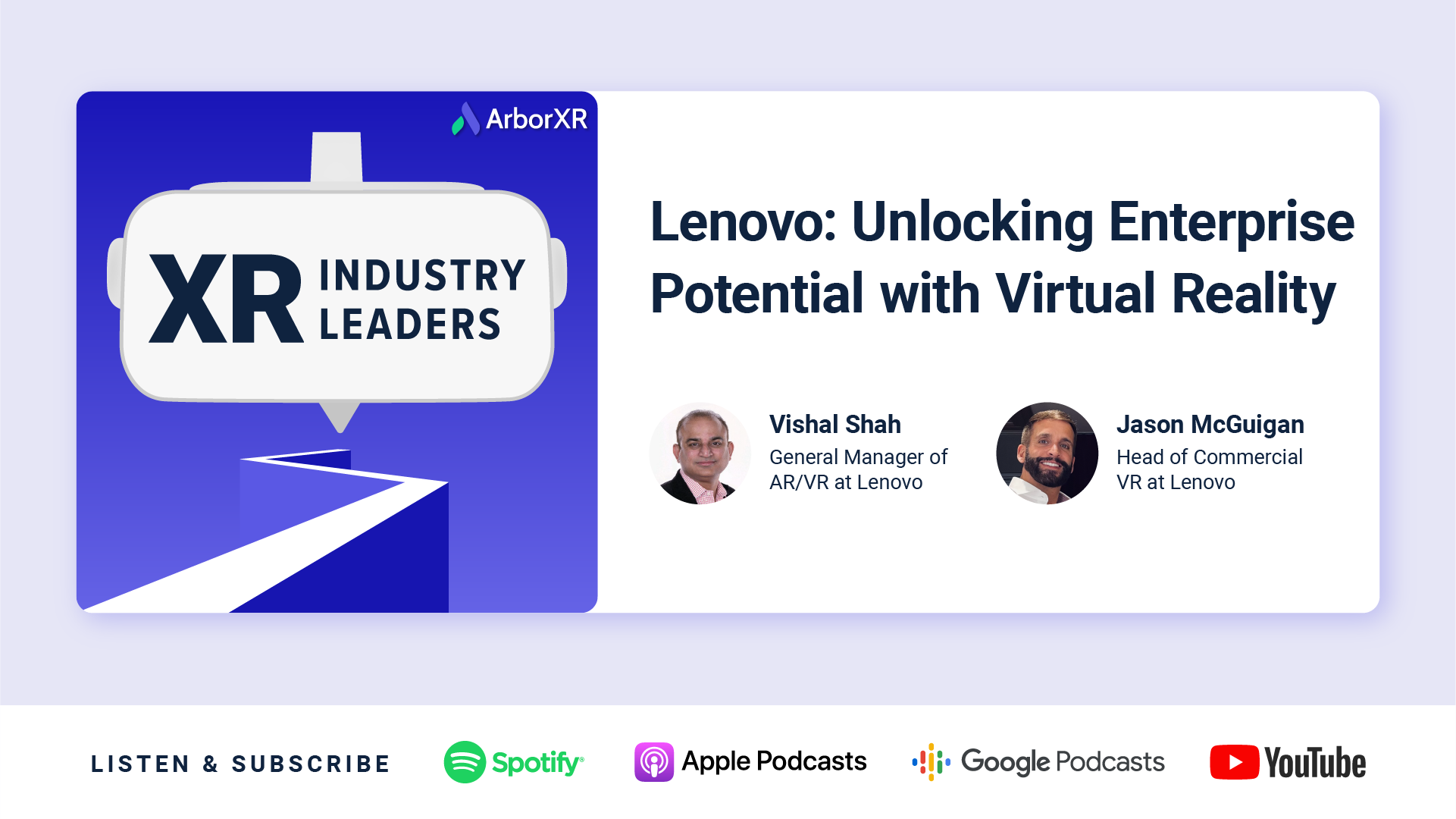
Lenovo: Unlocking Enterprise Potential with VR
Dive into the dynamic world of extended reality (XR) with Lenovo’s Vishal Shah and Jason McGuigan as they unravel Lenovo’s new enterprise XR solution: the Lenovo ThinkReality VRX.

PICO: Practical Enterprise Applications in XR at Scale
Explore XR’s future with PICO’s Amir Khorram in XR Industry Leaders. Insightful discussion on VR enterprise solutions, partnerships, and industry adoption.
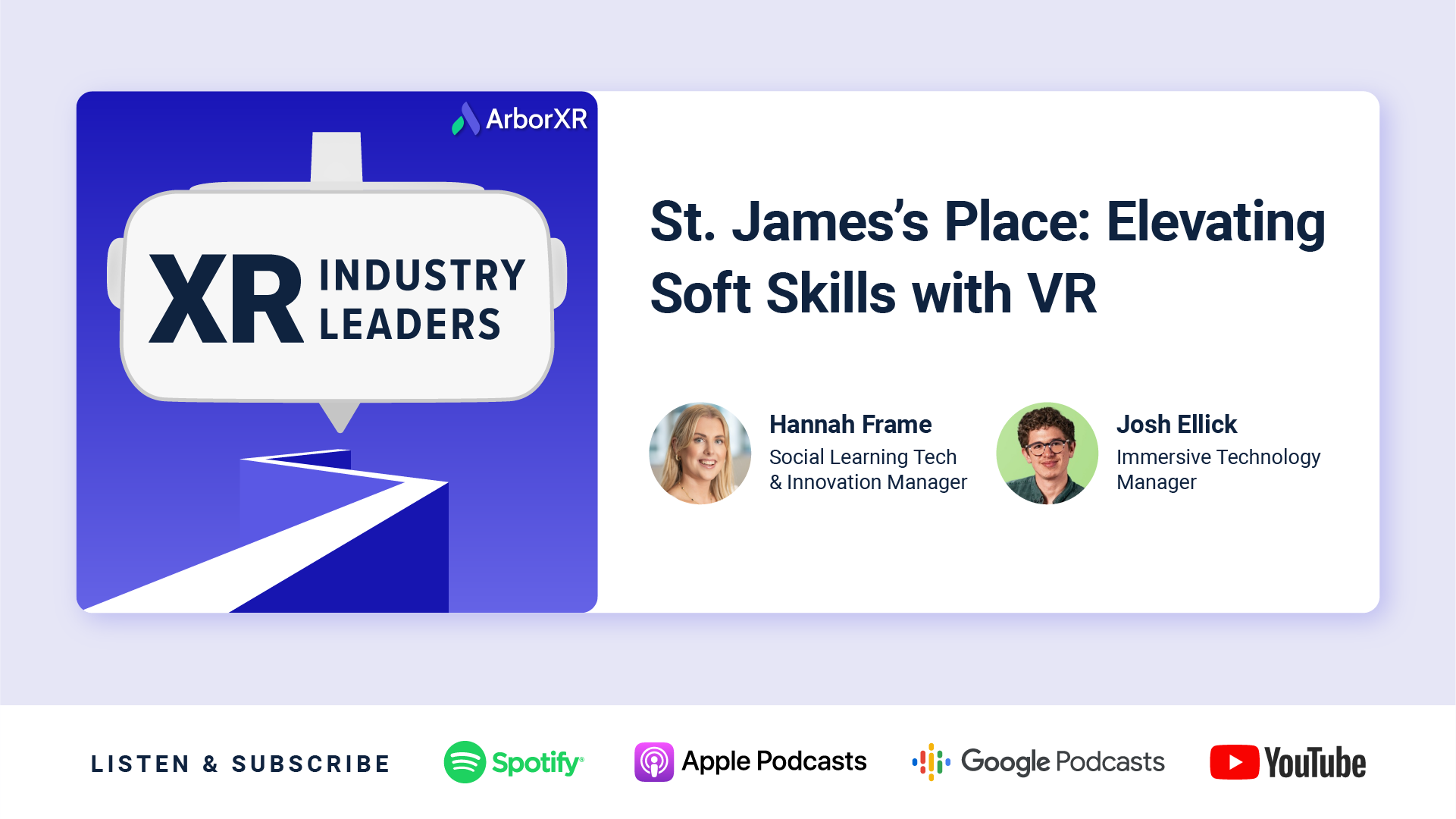
St. James’s Place: Elevating Soft Skills with VR
Hannah & Josh St. James’s Place discuss using VR to train advisor soft skills, challenges of managing headsets at scale, lessons on user adoption, and content development.
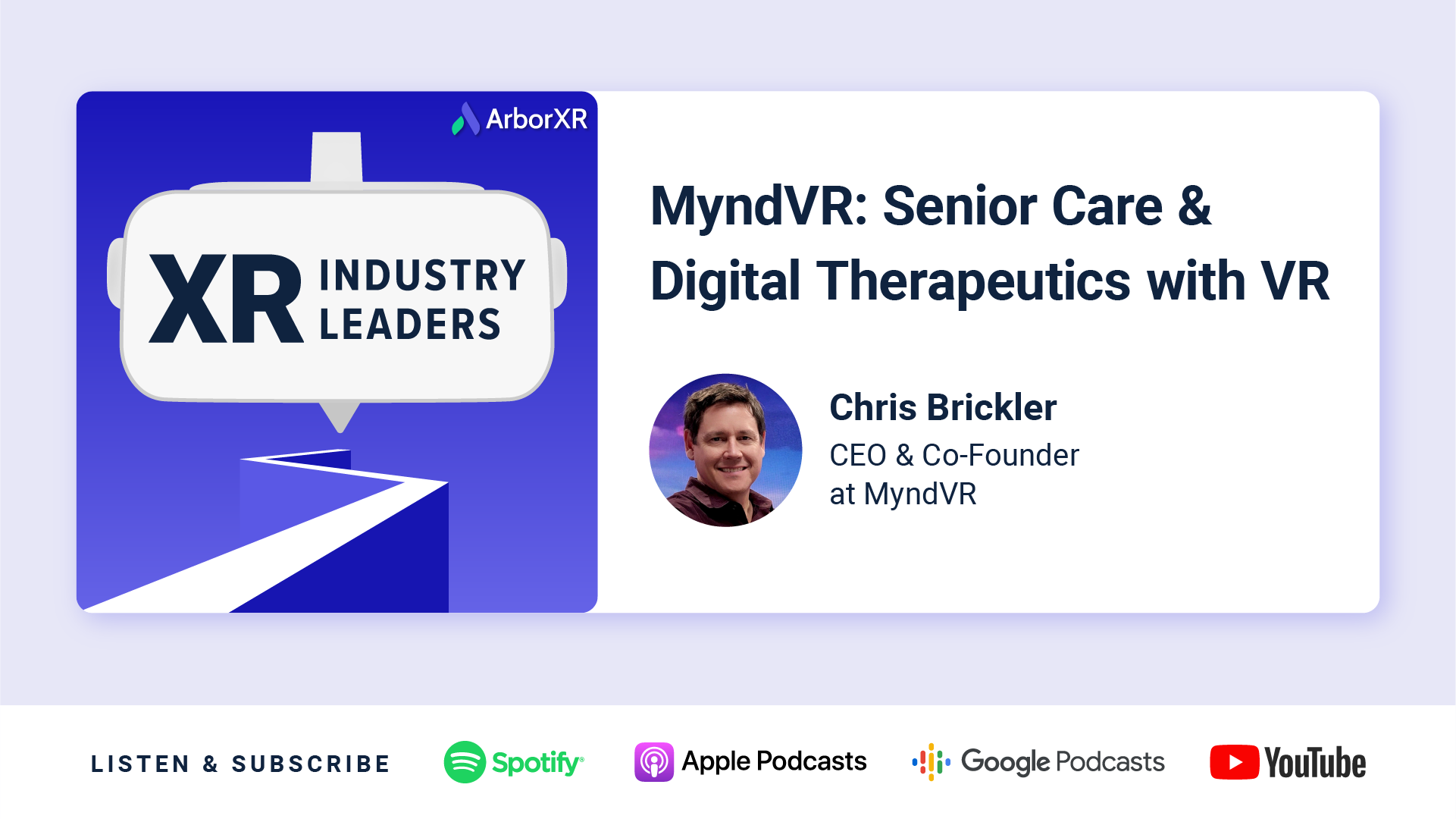
MyndVR: Senior Care and Digital Therapeutics with VR
Chris Brickler shares how VR therapy improves memories and care for elderly patients, and the challenges of scaling VR across health senior care facilities.
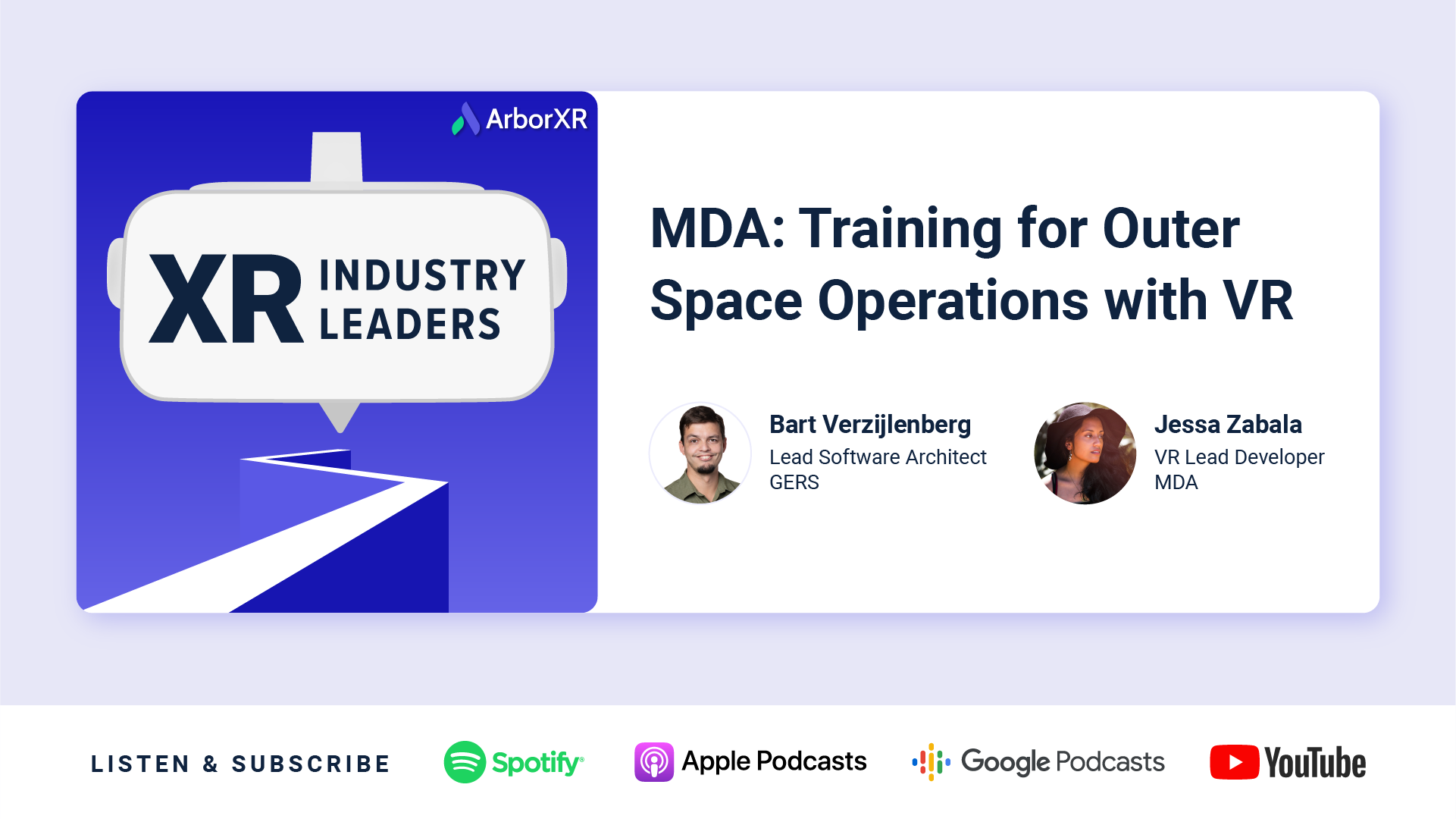
MDA: Training For Outer Space Operations with VR
Discover how MDA leverages VR for astronaut training, mission planning, and onboarding. Gain valuable insights into implementing immersive technologies at scale.

Harvard: Experiential VR Learning in Education
Matt Cook from Harvard joins us to discuss how virtual & augmented reality are redefining higher education through customized immersive experiences.
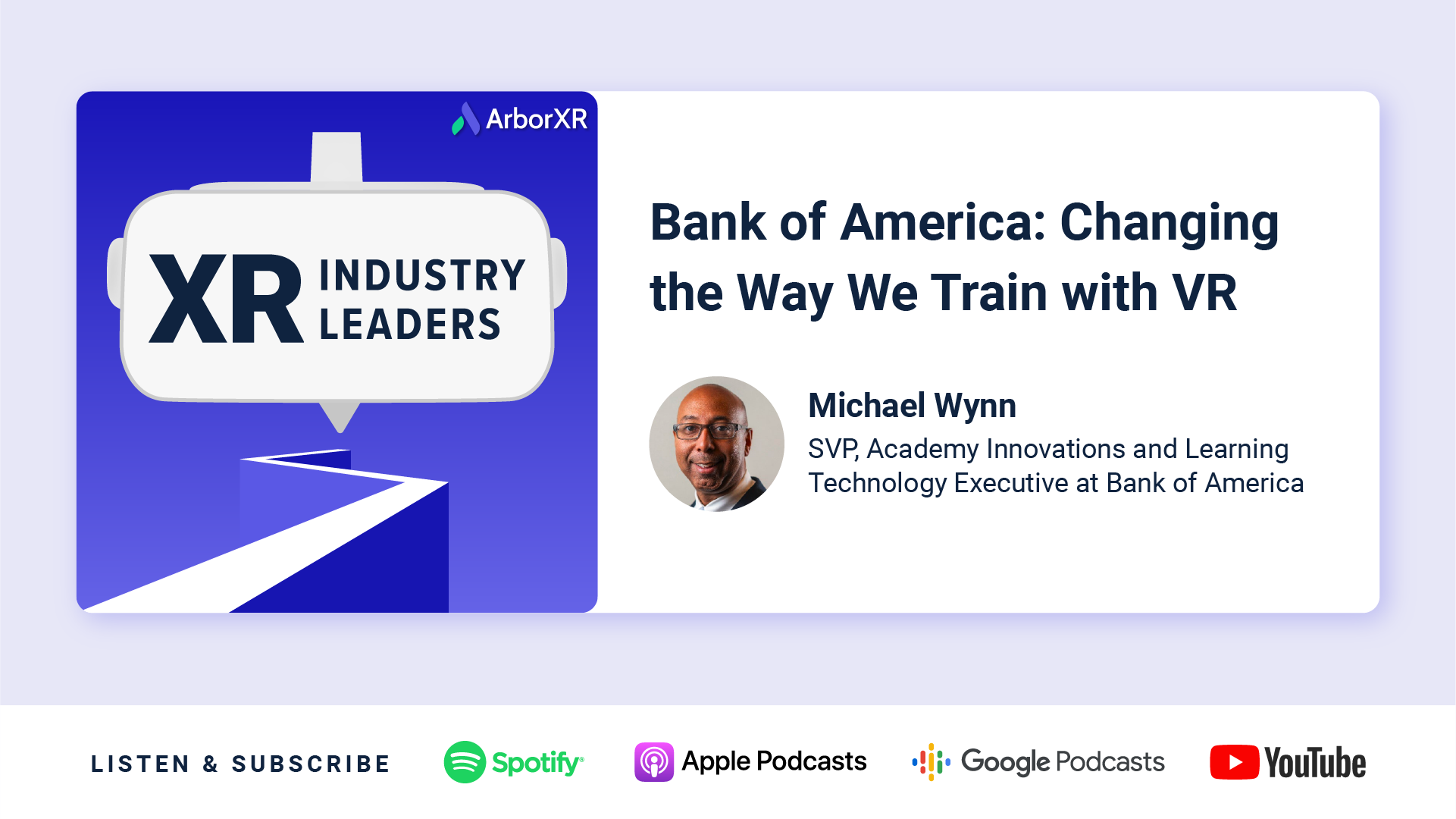
Bank of America: Changing the Way We Train with VR
Explore how Bank of America is revolutionizing training with VR, enhancing employee engagement, overcoming challenges with VR, and redefining corporate education.
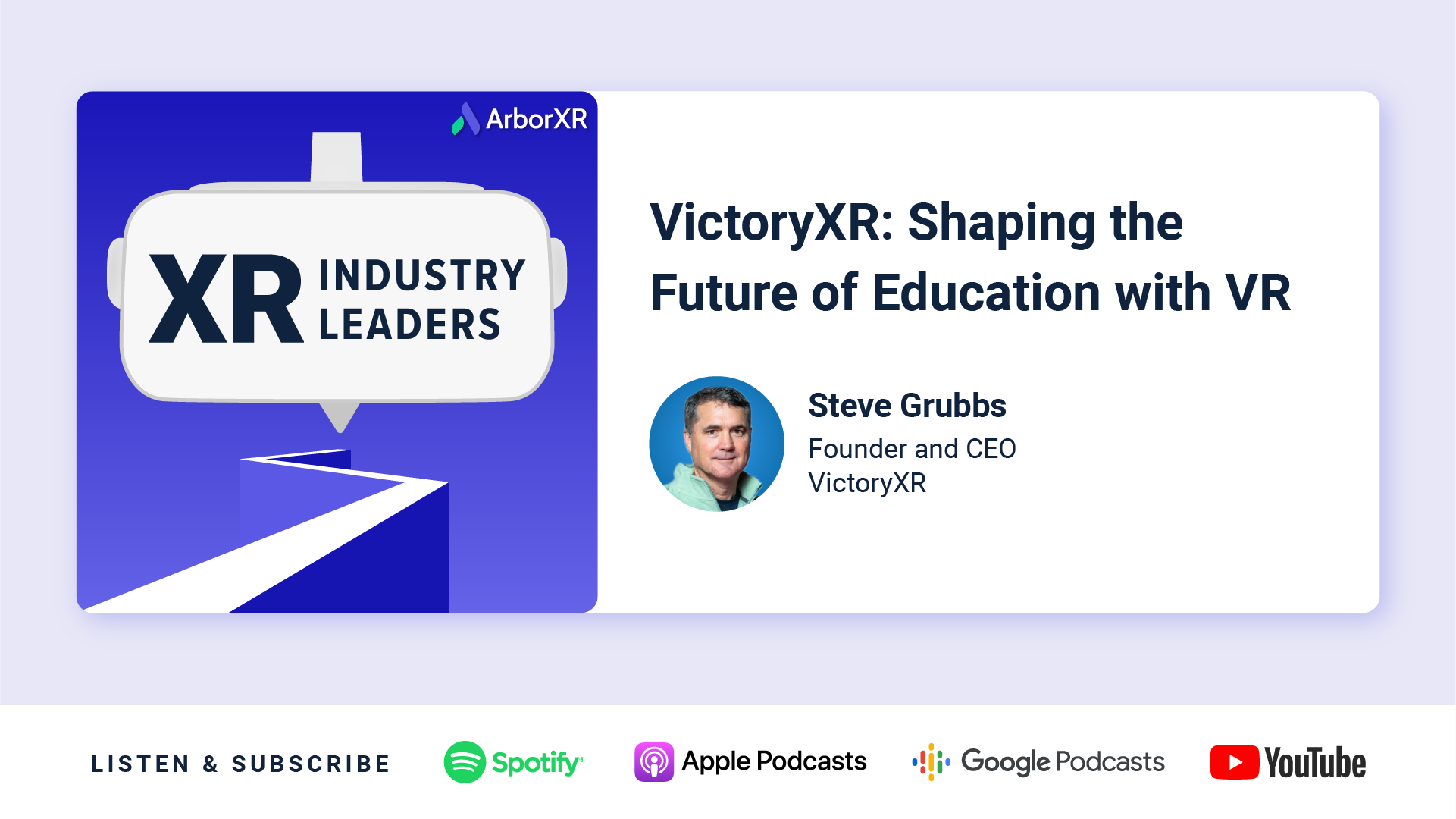
VictoryXR: Shaping the Future of Education with VR
VictoryXR CEO Steve Grubbs discusses creating virtual reality curriculums for education, working closely with Meta, and the future of immersive technology for teachers and students.

VRpatients: Designing Your Own VR Training for Healthcare
Learn how VRpatients creates VR simulations that instructors can customize to give trainees real-life experiences in healthcare.
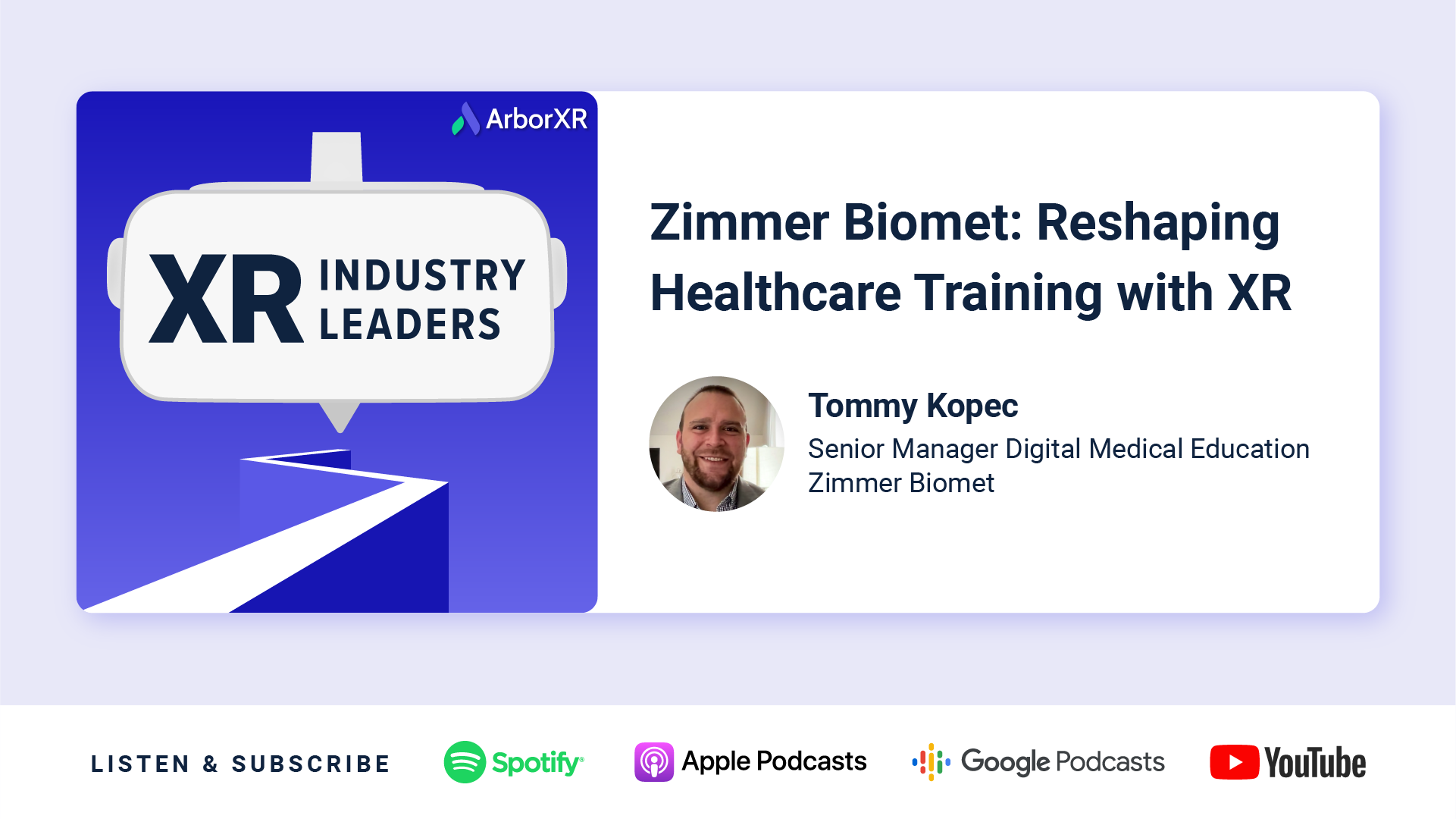
Zimmer Biomet: Reshaping Healthcare Training with AR and VR
If you’re interested in how XR will shape medicine going forward, this is a must-listen episode. Tommy Kopec of Zimmer Biomet provides an insider’s perspective on VR’s transformative potential for surgery, training, and beyond.

Lenovo: Unlocking Enterprise Potential with VR
Dive into the dynamic world of extended reality (XR) with Lenovo’s Vishal Shah and Jason McGuigan as they unravel Lenovo’s new enterprise XR solution: the Lenovo ThinkReality VRX.

PICO: Practical Enterprise Applications in XR at Scale
Explore XR’s future with PICO’s Amir Khorram in XR Industry Leaders. Insightful discussion on VR enterprise solutions, partnerships, and industry adoption.

St. James’s Place: Elevating Soft Skills with VR
Hannah & Josh St. James’s Place discuss using VR to train advisor soft skills, challenges of managing headsets at scale, lessons on user adoption, and content development.

MyndVR: Senior Care and Digital Therapeutics with VR
Chris Brickler shares how VR therapy improves memories and care for elderly patients, and the challenges of scaling VR across health senior care facilities.

MDA: Training For Outer Space Operations with VR
Discover how MDA leverages VR for astronaut training, mission planning, and onboarding. Gain valuable insights into implementing immersive technologies at scale.

Harvard: Experiential VR Learning in Education
Matt Cook from Harvard joins us to discuss how virtual & augmented reality are redefining higher education through customized immersive experiences.
Upcoming
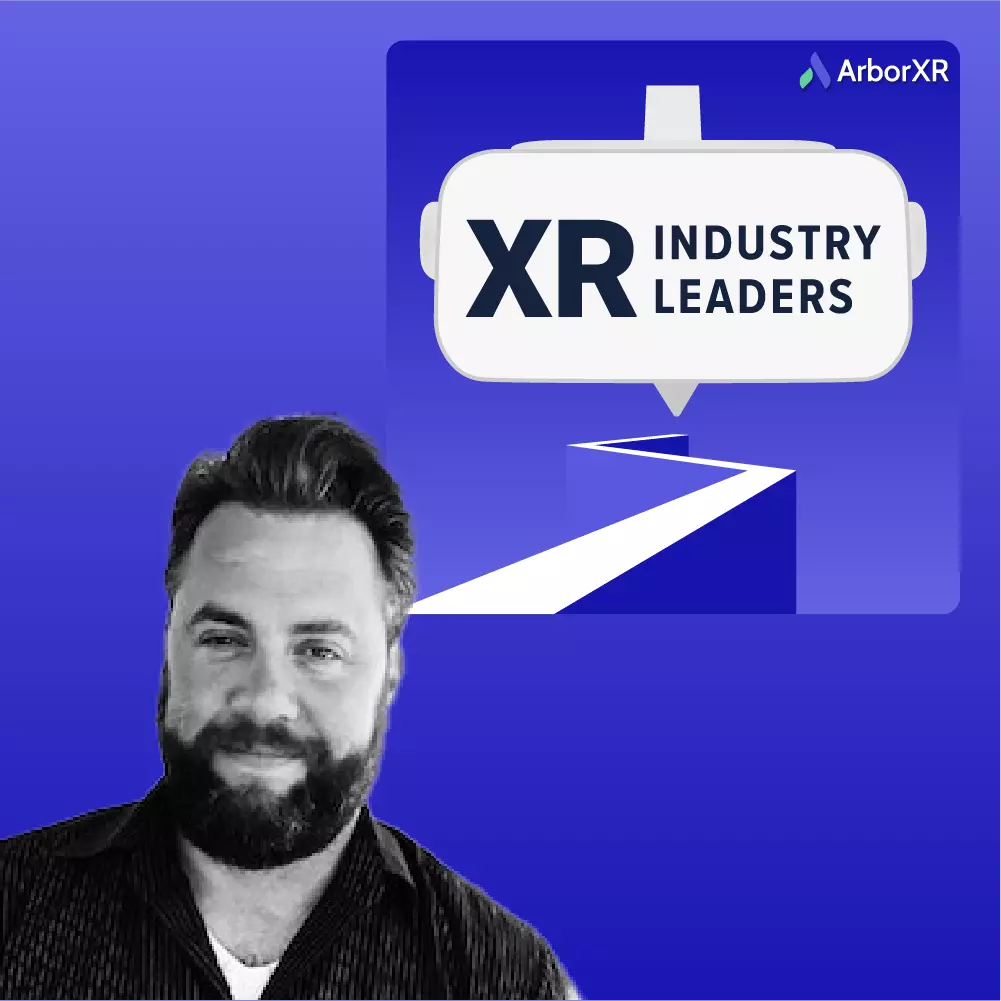
Upcoming Episode
Amazon (AWS)
With Stephen Curtis, Senior Prototyping Architect for Spatial Computing at Amazon Web Services (AWS)
Available: March 2023
